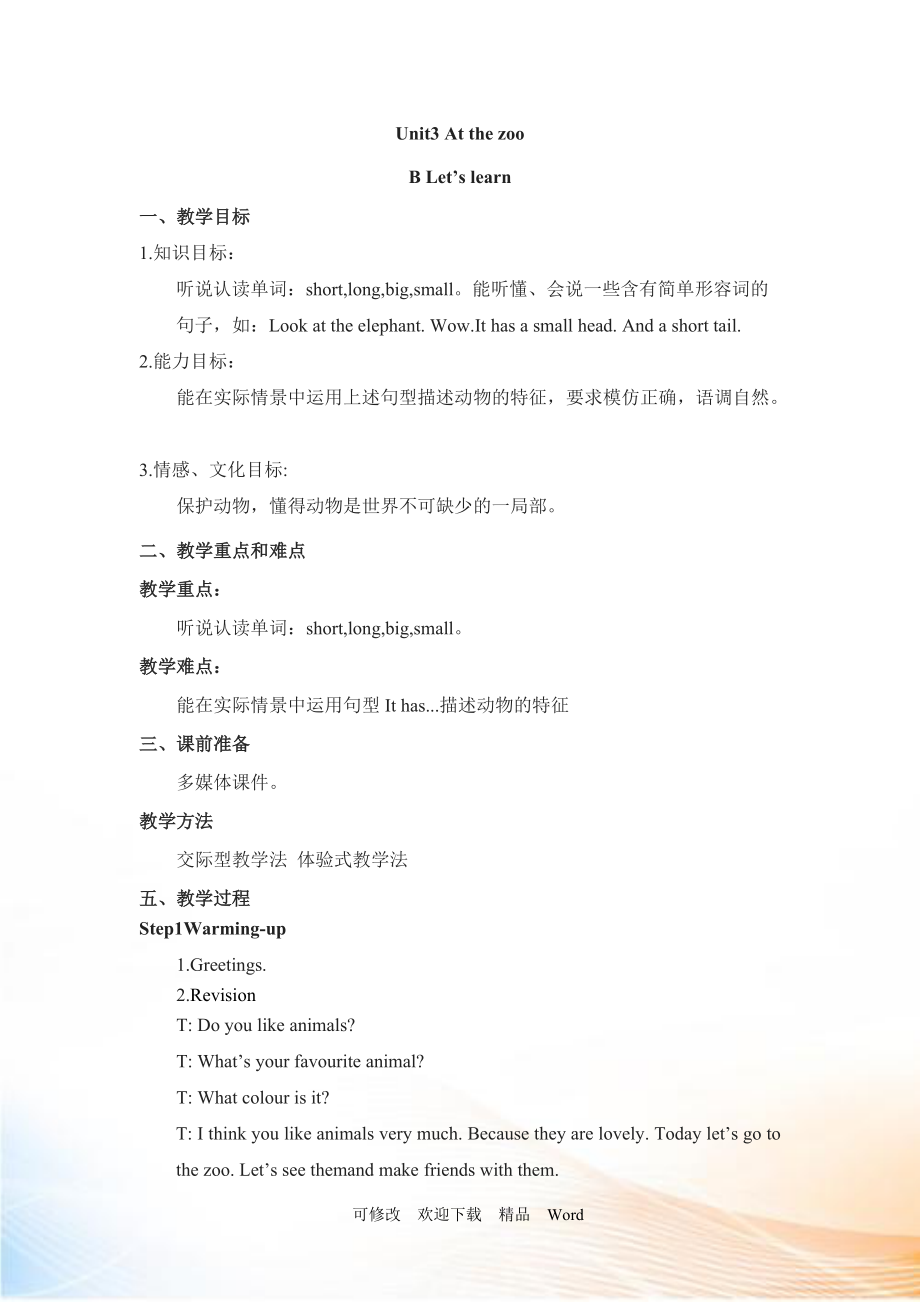《PEP版三年級(jí)下英語(yǔ)Unit 3 B Let's learn1》由會(huì)員分享�����,可在線閱讀�����,更多相關(guān)《PEP版三年級(jí)下英語(yǔ)Unit 3 B Let's learn1(3頁(yè)珍藏版)》請(qǐng)?jiān)谘b配圖網(wǎng)上搜索�����。
1�����、Unit3 At the zooB Lets learn一�����、教學(xué)目標(biāo)1.知識(shí)目標(biāo):聽(tīng)說(shuō)認(rèn)讀單詞:short,long,big,small。能聽(tīng)懂�����、會(huì)說(shuō)一些含有簡(jiǎn)單形容詞的句子�����,如:Look at the elephant. Wow.It has a small head. And a short tail.2.能力目標(biāo): 能在實(shí)際情景中運(yùn)用上述句型描述動(dòng)物的特征�����,要求模仿正確�����,語(yǔ)調(diào)自然�����。3.情感�����、文化目標(biāo): 保護(hù)動(dòng)物�����,懂得動(dòng)物是世界不可缺少的一局部�����。二�����、教學(xué)重點(diǎn)和難點(diǎn)教學(xué)重點(diǎn): 聽(tīng)說(shuō)認(rèn)讀單詞:short,long,big,small�����。教學(xué)難點(diǎn): 能在實(shí)際情景中運(yùn)用句型It has.描述動(dòng)物的特
2�����、征三�����、課前準(zhǔn)備 多媒體課件�����。教學(xué)方法 交際型教學(xué)法 體驗(yàn)式教學(xué)法五、教學(xué)過(guò)程Step1Warming-up1.Greetings.2.RevisionT: Do you like animals? T: Whats your favourite animal? T: What colour is it? T: I think you like animals very much. Because they are lovely. Today lets go to the zoo. Lets see themand make friends with them.Step 2Presentatio
3�����、n1.出示課件導(dǎo)入新課T: Lets go to the zoo.T: Look! Whats this?S: Its a panda.T: Is it thin?S: No. Its fat.2.學(xué)習(xí)新單詞�����。(出示課件)(1)T: Look at the ostrich.The head is small. Small means“小的�����。The body is big. big means“大的�����。板書(shū)單詞small, big領(lǐng)讀�����,跟讀�����。(2)體驗(yàn)式教學(xué)T: Ann, come here. This is my coat. Please put it on. Wow, its too big.
4�����、 I think its too big for her. Is it big?S:Yes. (3)Lets look at the ostrich again. The tail is short. And the legs are long. short means“短的�����。long means“長(zhǎng)的�����。板書(shū)單詞short, long領(lǐng)讀�����,跟讀�����。(4)體驗(yàn)式教學(xué)T: Mike, come here. Give me your arms. Look ,my arms are long. And his arms are short. My legs are long. His legs are
5�����、short. Because Im old. Hes young. I think he is taller and stronger than me in the future. (5)聽(tīng)錄音跟讀�����。書(shū)28頁(yè),聽(tīng)音�����,手指跟讀。Step 3Practice1.游戲(反義詞)Longshort bigsmall2.Lets chant. (改編歌謠)Be small. Be small. Be small, small, small.Be big. Be big. Be big,big, big.Be long. Be long. Be long, long, long.Be short. Be
6、short. Be short, short, short.Step 4Learn sentences1.T: Look at the ostrich. Wow.It has a small head. And a short tail.板書(shū)句型It has.并介紹引導(dǎo)學(xué)生介紹 It has a big body. It has a short tail. It has a big mouth. It has small eyes. It has long legs. 2.Group work: Describe the elephant.Look at the. It has.小組匯報(bào)�����。小組
7�����、合作能增強(qiáng)學(xué)生的競(jìng)爭(zhēng)意識(shí)�����,還能幫助到后進(jìn)生�����。Step 5ExtensionMake a monster六人一組�����,拿出事先準(zhǔn)備好的動(dòng)物身體部位圖片,學(xué)生A用兩三句話描述想象中怪物的模樣�����,學(xué)生B用拼圖的方式拼出一只怪物�����,學(xué)生A檢查學(xué)生B拼的怪物�����,然后一起描述其特征�����。學(xué)生實(shí)際運(yùn)用所學(xué)語(yǔ)言�����,也培養(yǎng)了學(xué)生之間的合作意識(shí)�����。Step 6Emotional EducationAnimals are our friends. Please protect them.Step7: Homework.1.描述自己家的小動(dòng)物�����。2.完成伴讀口語(yǔ)練習(xí)。板書(shū)設(shè)計(jì) Unit 3 At the zoo smalleyes.It has bigears. a shorttail. longnose. 可修改 歡迎下載 精品 Word
 PEP版三年級(jí)下英語(yǔ)Unit 3 B Let's learn1
PEP版三年級(jí)下英語(yǔ)Unit 3 B Let's learn1

